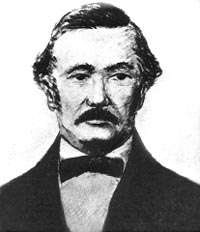Jean-Marie Le Bris
Jean Marie Le Bris (25 March 1817 – 17 February 1872) was a French aviator, born in Concarneau, Brittany, who accomplished a glider flight in December 1856.



Life and works
A sailor and sea captain, Le Bris sailed around the world observing the flight of the albatross. Although he sailed around the world, his true ambition was to fly. He caught some of the birds and analysed the interaction of their wings with air, identifying the aerodynamic phenomenon of lift, which he called "aspiration".
Le Bris built a glider, inspired by the shape of the Albatross and named L'Albatros artificiel ("The artificial Albatross"). In 1856 he flew briefly on the beach of Sainte-Anne-la-Palud (Plonévez-Porzay, Finistère), the aircraft being placed on a cart towed by a horse.[1] He thus flew higher than his point of departure, a first for heavier-than-air flying machines, reportedly to a height of 100 m (330 ft), for a distance of 200 m (660 ft).
In 1868, with the support of the French Navy, he built a second flying machine, which he tried in Brest without great success.[2] It was almost identical to his first flying machine, except that it was lighter and had a system to shift weight distribution. His flying machine became the first ever to be photographed, albeit on the ground, by Nadar in 1868, although the first well-documented glider was built by George Cayley and flown by an employee in 1853. Also in Great Britain, Stringfellow had built small unmanned gliders in 1848. However Le Bris invented more effective flight controls, which could act on the incidence of wings and which were patented in March 1857.
Le Bris died in Douarnenez in 1872.
See also
- List of early flying machines
- Timeline of aviation - 19th century
- History of aviation
- Félix du Temple
- Early flying machines
Notes
- Gibbs-Smith 2008, p.47
- Gibbs-Smith 2008 p.47
Bibliography
- Chanute, Octave Progress in Flying Machines. The American Engineer and Railroad Journal. 47 Cedar Street, New York, 1894, 1899
- Gibbs-Smith, C.H. Aviation: An Historical Survey. London, NMSI, 2008. ISBN 1 900747 52 9
- Opdycke, Leonard E. French Aeroplanes Before the Great War Atglen, PA: Schiffer, 1999. ISBN 0 7643 0752 5